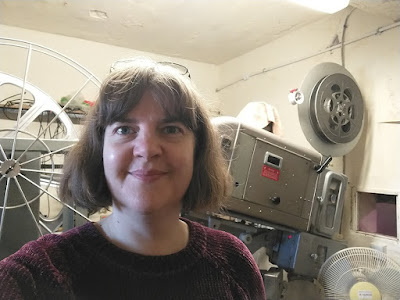Where do you get your ideas? For me the things I want to write about are the same things I was passionate about as a child.
I loved daytrips to Blackpool with my family when I was growing up, visiting Blackpool Tower, the Illuminations and its many other attractions. So, it felt right to set my 1930s Gracie Fairshaw mystery series there.
For the third book in the series, Gracie Fairshaw and the
Missing Reel (published on World Book Day, March 7th) I decided to
set the story around the filming of a movie in the resort.
I knew that another Gracie, Gracie Fields – the Rochdale
born superstar singer and actress had made a film in Blackpool in 1934. In fact,
I had watched and studied Sing as We Go as part of my degree in journalism,
film & broadcasting as well as writing my dissertation on the actress!
I loved that the film was shot on location, with key scenes recorded at the Pleasurebeach funfair, the open-air baths, sideshows and the Blackpool Tower circus.
In my book, the cast and crew are recording a fictional thriller called Room for a Traitor, when my heroine, young newspaper reporter, Gracie Fairshaw, learns that an important reel of film has gone missing.
To add authenticity to the film-making scenes, I visited Blackpool Central
Library and looked at old copies of the Gazette newspaper on microfiche (as I
had with the previous two Gracie books.)
I was able to see the cameras that were used and was intrigued by the fact that Gracie had had a body double/stuntwoman. I went on to learn that Lilian Tollis had been a stage actress herself as well as a dancer, sometimes using the name Zetta Morenta.
I knew I wanted to include a similar character in my
story – but I didn’t know much about stunt work. So, I did more research, reading a number of books on the subject.
I learned that in the early days of moviemaking, the
stars often performed their own stunts.
In the silent film era, directors, script writers and
performers were often women.
Half of all American films made before 1925 were
written by women!
Dramatic serials like the Perils of Pauline were very
popular with their cliffhangers, and gutsy heroines.
The female stars often performed their own stunts,
with many hired because they were strong swimmers, good at driving motorcars,
or were skilled acrobats.
Sometimes stuntwomen were hired, and then became leads
themselves, but as the work became better paid, men started to take over –
wearing wigs and dresses to look like the stars.
It was said that most stunt workers only lasted five
years. Lots were killed or badly injured. For example, in 1929, sixteen men
were killed, including three stunt pilots making the film Hell’s Angels!
(Sadly, stunt work is still very dangerous. Actor Rory
Kinnear, whose father died in a stunt accident, continues to campaign for
better training and awareness of the dangers involved.)
With the introduction of sound, cinema attendance grew and the film making became big business – women were pushed aside, and only certain poorer paid roles were generally deemed suitable for them.
Although Hollywood is often the place we associate with film making, Britain had its own studios, most were in London, but there was a northern company - Mancunian Films based in Manchester who also shot a movie in Blackpool - Holidays with Pay.
In 1927 the Cinematograph Films Act was introduced which insisted that a specific percentage of British produced movies that had to be shown domestically. Unfortunately while some brilliant movies were produced, this led to a lot of poorer quality ones too, dubbed 'Quota Quickies.'
It opened in 1939 and had 3,088 seats!
Unemployment in the 1930s saw people visiting the cinema as an escape from their worries. Many new cinemas were built, some in exotic architectural styles.
By 1938 there were 4,907 cinemas in the UK and around that same time Blackpool alone had 17!
Inspiration for two more characters in my book came from a real-life director Alfred Hitchcock and editor/screenwriter Alma Reville. They were married and often worked together on exciting thrillers including the first British made ‘talkie’ Blackmail.
I also enjoyed setting scenes in Blackpool’s stunning Winter Gardens. This Victorian era entertainment complex went through a transformation in the 1930s. New rooms were created that looked like a Spanish village, a pirate ship and a baronial hall! These new designs were created by Andrew Mazzei, who also worked as an art director on British films!
The Spanish Hall, Winter Gardens (photograph Susan Brownrigg)
The climax of Gracie Fairshaw and the Missing Reel takes place on the roof of the Regent Cinema in Blackpool – which still exists today, as well as showing popular classic movies, it also houses an antiques centre. I was lucky to be allowed into the projection room - a real treat for a movie lover like me!
Susan Brownrigg in the projection room, The Regent Cinema,
Lights, camera, action!
A new movie being filmed in Blackpool is a real scoop for trainee reporter Gracie Fairshaw.
When she's invited to interview the star, Sally Sunshine, Gracie uncovers a plot as exciting as the one being filmed. Someone has stolen a vital film reel - and then a vicious attack is attempted on Sally!
In a world of body-doubles, stunts, costumes and makeup, not everything is what it seems.
Gracie must go behind the scenes and work out, which of the cast and crew can;t be trusted before the shoot comes to a thrilling climax at the town's cinema.
Gracie Fairshaw and the Missing Reel is published on Thursday 7th March. You can preorder a signed copy HERE
Susan Brownrigg is the author of the Gracie Fairshaw mystery series and Kintana and the Captain's Curse, a treasure hunt adventure featuring pirates and lemurs!
(UCLan Publishing)
Find out more at susanbrownrigg.com







No comments:
Post a Comment